Nikon DX AF-S Nikkor 35mm 1: 1.8G SWM Aspherical (abbreviated as Nikon 35mm f / 1.8G DX) was announced on February 9, 2009. Now this lens is quite popular and it is easy to find both new and used.
In brief about the Nikon DX AF-S Nikkor 35mm 1: 1.8G SWM Aspherical
Nikon 35mm f / 1.8G DX IS standard fast fixed lens for Nikon DX cameras... In this case, the word 'standard' refers to the focal length and means that the lens provides a moderate angle of view of 44 ° across the frame.
Nikon 35mm f / 1.8G DX has large aperture... The maximum relative aperture to which the lens aperture opens is 1: 1.8, which is a very good indicator. The Nikon 35mm f / 1.8G DX is usually a complement to 'dark' versatile zoom lenses such as Nikon 18-55mm 1: 3.5-5.6GII VR II AF-S DX Nikkor or Nikon 18-105mm 1: 3.5-5.6G ED Nikkor VR AF-S SWM DX IF Aspherical. If we compare the maximum aperture of F / 5.6 used in these zoom lenses with the F / 1.8 used in the Nikon 35mm f / 1.8G DX, the difference will be more than 2 steps, which is about 10 times. Thus max aperture this lens is 10 times larger than regular zoom lenses mounted at the extreme zoom position. So big aperture simplify shooting in low-light conditions. For example, in due time I shot without problems on this lens in temples wedding ceremoniesand baby baptism.
Nikon 35mm f / 1.8G DX is a fixed lens, which means its focal length is always the same (there is no zoom function). Fix lenses make it much easier and at a more modest price to get very good optical performance. So, this Nikon 35mm f / 1.8G DX has very good sharpness, inaccessible to a large number of zoom lenses.
The Nikon 35mm f / 1.8G DX is also a very compact and lightweight lens, it is easy and simple to always carry. Below you can see photos from my vacation, for which I took a lightweight Nikon 35mm f / 1.8G DX along with a lightweight camera Nikon D40.
To summarize quickly, the Nikon 35mm f / 1.8G DX is a lens from the category 'Must Have'. 35 mm focal length on the camera Nikon DX give the same angle of view as a 52.5mm lens (virtually the same 'half a ruble') on the camera Nikon fx. Such a lens is suitable for a wide range of photo tasks.
Main technical characteristics of Nikon DX AF-S Nikkor 35mm 1: 1.8G SWM Aspherical:
| Review Instance Name | Nikon DX AF-S Nikkor 35mm 1: 1.8G SWM Aspherical 2166388 |
| Basic properties |
|
| Front Filter Diameter | 52 mm, plastic thread for filters |
| Focal length | 35mm Equivalent Focal Length (EGF) for cameras Nikon DX is 52,5 mm (Spoiler: I’ll soon get away from these meaningless comments about focal lengths and their recounting. Everything is exactly as described above. Without options.) |
| Zoom ratio | 1 X (this is a fixed lens, it does not have a zoom) |
| Designed by | for Nikon DX digital cameras (with APS-C sensor) |
| Number of aperture blades | 7 rounded pieces |
| Tags | bayonet mount tag and hood mount |
| Diaphragm | F / 1.8 to F / 22, without aperture ring. |
| MDF | 0.3 m, the maximum magnification ratio is 1: 6.3 (the smaller the second number, the better the ability to macro) |
| The weight | 200 g |
| Optical design | 8 elements in 6 groups, 1 aspherical element (in the optical diagram, the aspherical element is shown in blue). The presence of such elements on the lens barrel is indicated by the inscription 'Aspherical'. The image of the optical circuit is clickable.
Most likely the aspherical element is a hybrid aspherical, i.e. consisting of a conventional spherical lens coated with plastic aspherics. |
| Lens hood | Nikon HB-46 |
| Manufacturer country | MADE IN CHINA (Made in China) |
| Period | From March 2009 to the present |
| Instructions | View -> |
| 3d view | View -> |
| Price |
It just so happens that the Nikon 35mm f / 1.8G DX is the only truly 'fast' prime lens specifically designed for cameras Nikon DX. Other fixed lenses Nikon
- Nikon DX AF Fisheye Nikkor 10.5mm 1:2.8G ed
- Nikon DX AF-S Micro Nikkor 40mm 1:2.8G SWM.
- Nikon DX AF-S Micro Nikkor 85mm 1:3.5G ED VR SWM IF Micro
have much less aperture.
Assembly
The copy from this review was made in China. The Nikon 35mm f / 1.8G DX is quite pleasant to the touch, its plastic body does not cause any discomfort. It is very good that the lens uses a metal mount, which is at least some sign of a quality lens assembly. The lens uses commonly used 52 mm filters.
Please note that the Nikon 35mm f / 1.8G DX mount side has a special dustproof and waterproof mount seal, which is an indication that the lens has a base mount. dust and moisture protection. Unfortunately, the rest of the case is not protected from the negative impact of the external environment. More information on the all-weather protection of Nikon SLR lenses can be found here.
Nikon 35mm f / 1.8G DX uses a rubberized focus ring. There are bayonet mount tags and a tag for quick hood installation on the case. The lens uses a strong plastic lens hood HB-46, which is fixed in special grooves located near the front lens of the lens. The lens hood comes with the lens. The hood can be installed in the opposite direction for transportation. In this position, access to the focus ring is completely lost.
The Nikon 35mm f / 1.8G DX comes with a soft velor case CL-0913, with which you can transport the lens.
Focusing
Nikon 35mm f / 1.8G DX focuses quietly thanks to 'SWM'-motor (Silent Wbird Motor - quiet wave motor) and refers to the lens'AF S'type (with built-in motor focusing), and therefore it will automatically focus on any Nikon digital SLR camera.
Auto Focus Speed - average. I want to note that the Nikon 35mm f / 1.8G DX focuses slower than Nikon AF-S Nikkor 50mm 1: 1.8G SWM Aspherical и Nikon 50mm 1: 1.8D AF Nikkor. On cameras Nikon D40 и Fujifilm FinePix S5 Pro the lens focuses tenaciously and does not release objects from the field of focus. Note that there are a lot of rumors on the net that the lens may not focus accurately (have 'back' or 'front' focus). I've had 4 different similar lenses in use all the time, and they all worked and focused properly.
During focusing, the front lens remains stationary. The lens uses RF focusing (Rear Focusing), which is done by moving the back of the lens group. For practical use, focusing type RF is no different from focusing type IF ('Iinternal Focus' - 'Inner Focus'). With this lens, you can easily use any filters, for example, polarizing.
The minimum focusing distance is only 30 cm, while you can shoot Macro with 1: 6.3 magnification... The Nikon 35mm f / 1.8G DX has neither a window with a distance scale, nor a depth of field scale, nor a mark for working in the infrared spectrum. In manual focusing mode, the ring rotates approximately 90 degrees, when reaching the extreme positions, it does not rest against it, but continues to slide without affecting focusing. Manual aiming is easy. True, some users of this lens still blame the tight rotation of the focusing ring.
On the lens housing you can find focus switch 'M / A - M'. In the 'M / A' position, auto focus works with constant manual focus priority. The 'M / A' mode is very convenient and useful - for manual focusing or focus correction, you do not need to additionally switch the lens to the 'M' mode. You can turn on the 'M / A' mode and forget about this switch forever.
Diaphragm
Diaphragm lens consists of 7 rounded petalswhich form a fairly even hole. Diaphragm closes to F / 22. The lens does not have an aperture control ring, nor does the DOF scale.
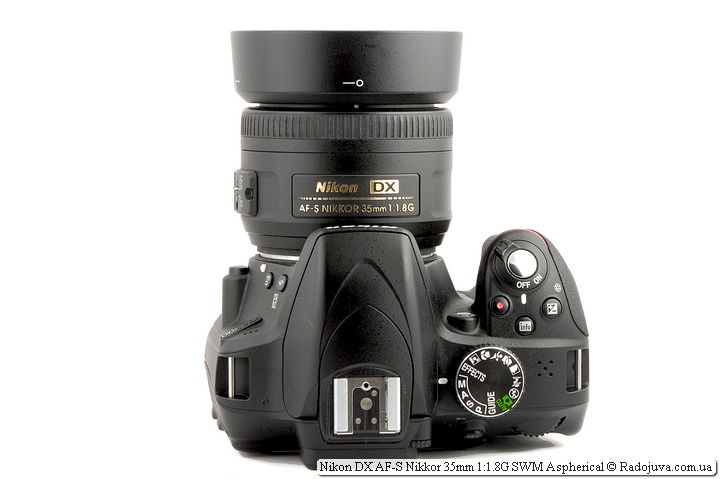
Nikon DX AF-S Nikkor 35mm 1: 1.8G SWM Aspherical with Nikon HB-46 lens hood Nikon D3300
Lens features on Nikon FX full-length cameras
Interesting: the lens has a good margin of performance, it can work with grief in half and on full-size Nikon FX cameras (for which it is not designed to work) Here is the link on mine sample photos on Nikkor AF-S 35mm f / 1.8G DX and full-format camera in FX image area mode.
Image quality
Good picture quality is obtained due to use aspherical element in the optical circuit of the lens. On foreign sites they write that the lens uses plastic inserts for a hybrid aspherical element, I did not find detailed information about this. Chromatic aberrations (HA) are highly visible until F / 3.2. The purple halo (Purple fringing), which is difficult to remove even when shooting in RAW and post-processing. To catch such a halo, you need to try. The purple halo border is the only major drawback of this lens.
In general, the lens has “cream” bokeh. Don't expect the lens at f / 1.8 to blur the background too much when photographing portraits. For portraits, any half a ruble (50mm fixed lens). I recommend reading my article about how to take pictures with a blurred background.
Distortion 35 mm still remained and quite a bit makes its own negative adjustments.
Vinienting imperceptibly at any aperture. Natural color renderingeasily fixed by setting white balance in the camera. Lens very sharp at any aperture.
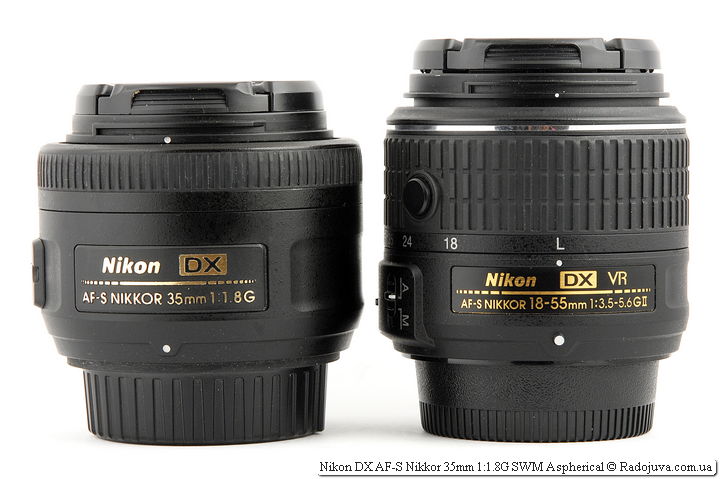
Dimensions Nikon DX AF-S Nikkor 35mm 1: 1.8G SWM Aspherical and Whale Lens Nikon 18-55mm 1: 3.5-5.6GII VR II AF-S DX Nikkor
Alternatives
If you are looking for a lens of this class, then The following lenses can serve as alternatives at a similar cost or functionality:
- Sigma 30mm F1.4 DC HSM ART
- Sigma 30mm 1: 1.4 EX DC HSM
- Nikon DX AF-S Micro Nikkor 40mm 1: 2.8G SWM
- Yongnuo 35mm 1: 2 (YN35mm F2N, for Nikon cameras)
My experience:
The 35 mm fix, even on the DX matrix, is quite short and not familiar to me, but shooting with this lens is a fairy tale! Ergonomics and functionality on top. All those who want to upgrade their whale lens, I recommend this particular Nikkor AF-S 35mm f / 1.8G DX.
More examples of photos on the Nikon DX AF-S Nikkor 35mm 1: 1.8G SWM Aspherical with source RAW files can be found in the review Nikon D3300.
Lens prices
The real prices for Nikon DX AF-S Nikkor 35mm 1: 1.8G SWM Aspherical can be found in stores and catalogs:
Comments on this post do not require registration. Anyone can leave a comment. Many different photographic equipment can be found on AliExpress.
It is often difficult to choose between Nikon DX AF-S Nikkor 35mm 1: 1.8G SWM Aspherical and Nikon AF-S Nikkor 50mm 1: 1.8G SWM Aspherical, thoughts about this find here.
I am also often asked how this lens differs from Nikon AF Nikkor 35mm 1: 2D, the difference is described in detail here.
An accurate list of all Nikon DX Nikkor lenses
- 10.5 mm/ 2.8G AF Fisheye [gold ring]
- 35 mm/1.8G AF-S
- 40 mm/2.8G AF-S Microphone
- 85 mm/3.5G AF-S VR Microphone
- 10-20 mm/4.5-5.6G AF-P VR
- 10-24 mm/3.5-4.5G AF-S
- 12-24 mm/4G AF-S [gold ring]
- 16-80 mm/ 2.8-4IN AF S VR [gold ring]
- 16-85 mm/3.5-5.6G AF-S VR
- 17-55 mm/2.8G AF-S [gold ring]
- 18-55 mm/3.5-5.6G AF-S [black / silver]
- 18-55 mm/3.5-5.6GII AF-S [black / silver]
- 18-55 mm/3.5-5.6G AF-S VR
- 18-55 mm/3.5-5.6GII AF-S VR
- 18-55 mm/3.5-5.6G AF-P
- 18-55 mm/3.5-5.6G AF-P VR
- 18-70 mm/3.5-4.5G AF-S
- 18-105 mm/3.5-5.6G AF-S VR [Thailand / China]
- 18-135 mm/3.5-5.6G AF-S
- 18-140 mm/3.5-5.6G AF-S VR [Thailand / China]
- 18-200 mm/3.5-5.6G AF-S VR [Japan / China]
- 18-200 mm/3.5-5.6GII AF-S VR
- 18-300 mm/3.5-5.6G VR
- 18-300 mm/3.5-6.3G VR
- 55-200 mm/4-5.6G AF-S [black / silver, Japan / China]
- 55-200 mm/4-5.6G AF-S VR
- 55-200 mm/4-5.6GII ED VR
- 55-300 mm/4.5-5.6G AF-S VR
- 70-300 mm/4.5-6.3G AF-P
- 70-300 mm/4.5-6.3G AF-P VR
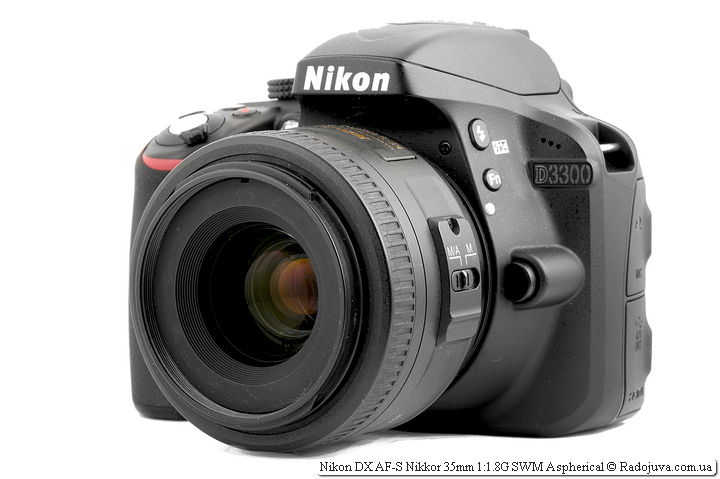
Nikon DX AF-S Nikkor 35mm 1: 1.8G SWM Aspherical on Camera Nikon D3300
Results
Nikon DX AF-S Nikkor 35mm 1: 1.8G SWM Aspherical is an excellent standard high-aperture prime lens for cropped Nikon DX cameras. The lens has excellent sharpness and compactness, works on all digital SLRs Nikon. The lens has only one serious drawback - strong purple halos on the contrasting details of the image.
If you have any question about this lens, feel free to ask it in the comments and they’ll answer for sure. Also, in comments write your reviews, impressions, opinions and ratings of this lens.
UPDATE 1: A cheap similar lens went on sale in 2016 - Yongnuo 35mm 1: 2 (YN35mm F2N, for Nikon cameras, review at this link).
UPDATE 2: in 2020, a large overview of the premium lens appeared on Radozhiv Sigma 30mm 1: 1.4 DC A (Art).
Material prepared Arkady Shapoval. Training/Consultations | Youtube | Facebook | Instagram | Twitter | Telegram

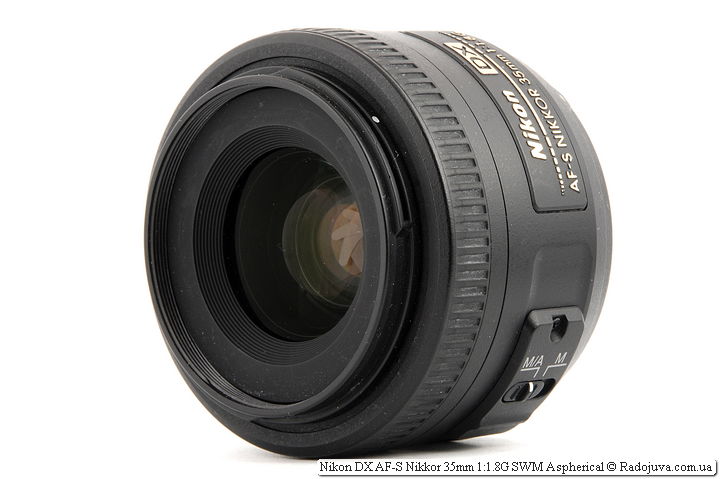




















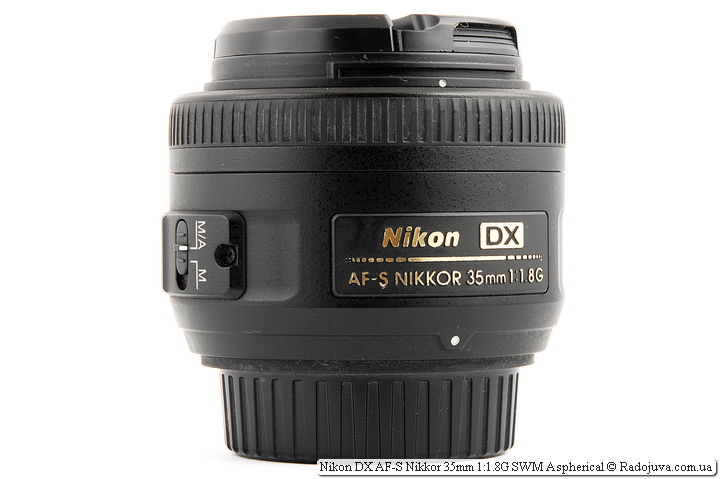
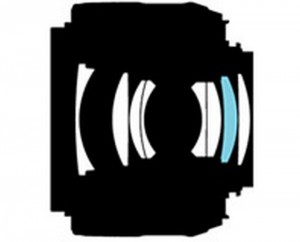
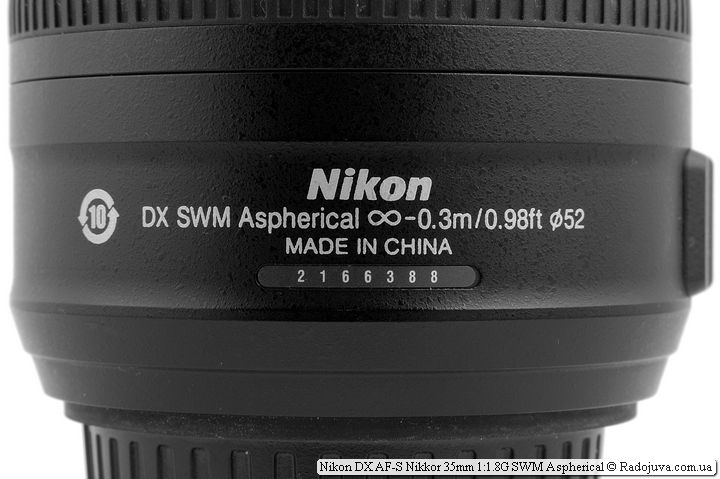
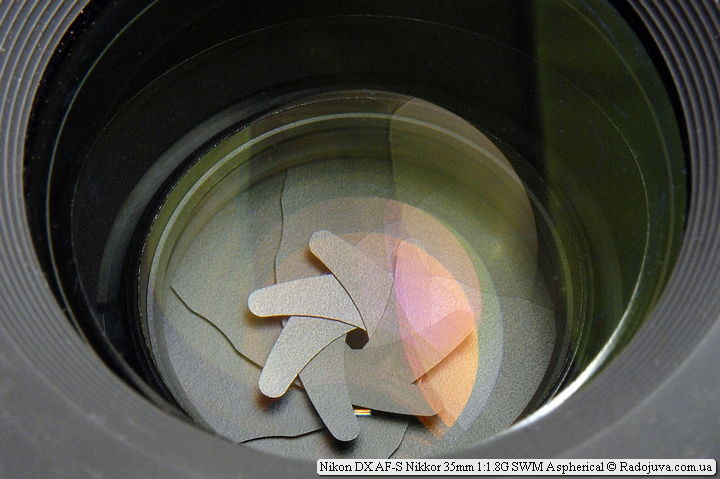















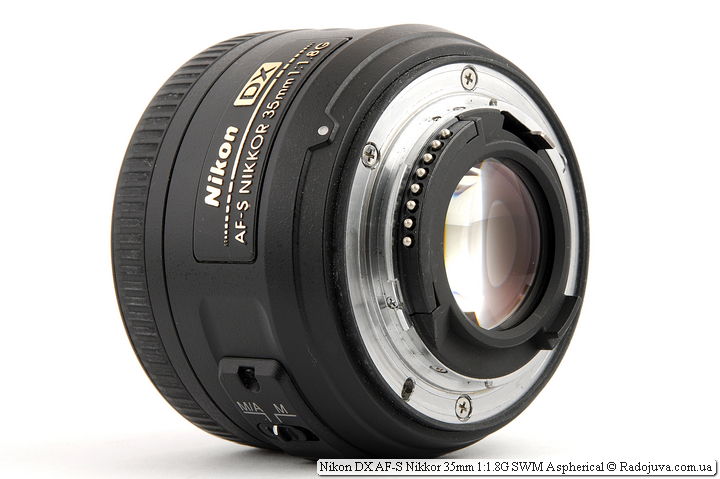
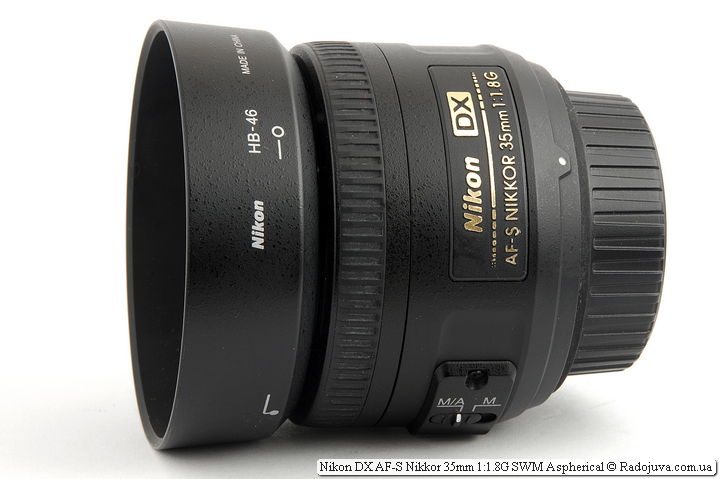
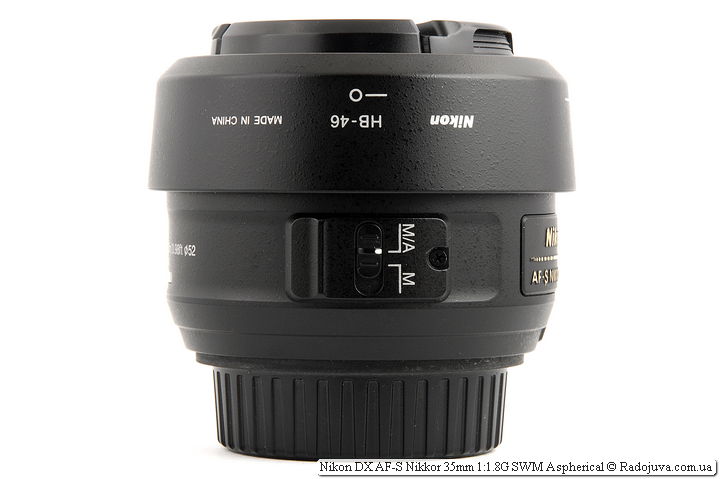































Tell a newbie. Going to "travel" there is a kit 18-105 and a 70-300 TV set. Is it enough or take a fix?
Well, after you sip on both lenses, then you yourself will understand that 18-105 is enough ... Although, if the excess weight does not bother you, you can wear both. And the fix on the travel is needed (as it seems to me) only for the landscape, but for this it is also desirable to have a tripod). Of course, if you travel by car or motorcycle, then yes, otherwise you will pump up the bituha ... :-)
there is a tripod))) I'm going to Abkhazia, so the landscape itself)))) I bought a backpack. Generally armed))) and very dangerous ... ..
18-105 enough with the head1 but if not against the gravity to sip then plus 70-300
If you have a backpack and your health allows, take everything together with a tripod, well, except for absolutely unnecessary things.
Good afternoon, Arkady!
Can you please tell me if your review of the new 35mm “Nikon 35mm f / 1.8G ED” and its comparison with the above lens is foreseen?
compare crop with ff? what's the point?
But what is the point of using FF-optics on crop?
Most often - due to the lack of analogs for the crop. Sometimes ff optics are taken “for growth”.
if on crop, then I can directly say that vignetting is less, distortion is less, and sharpness is comparable.
thanks Dmitry!
but, in addition to sharpness, there is also the “artistry” of the drawing ... or not?
no, there is no question of any artistry. All sorts of beautiful blur are characteristic of long-focus lenses and “normal” lenses with aperture of 1.4 and wider, but here in reality, apart from less vignetting, you will not see anything. In general, you can't see a nifig on the crop - all the so-called drawings are an alloy of unique lens jambs together and giving a "drawing". On the crop, everything is cut off and looks normal. The center of almost all lenses is sharp, and all modern lenses have normal contrast. Therefore, you will not find the difference. If you want artistry - take something more authentic, like 85 1.8 - be surprised. And the staff 35 1.8 dx. and you will be happy. In general, if you do not report on crop, you need to take 35 1.8 for everything, 85 1.8 for a portrait and birds, shirik zoom and long zoom as needed, that's all. Nafig fifty dollars, zoom 17-50 2.8 only if you do a report. Everything else, of course, I want to try, but it will not bring benefits for sure
The lens is very sharp, suitable for almost all occasions (on crop). I don’t know at the expense of what, but the color rendition is much juicier than on the whale. Gives great photos even in jpg without processing. Small, easy to carry, good equipment.
Manual focusing is not entirely convenient, since there are no tactile marks on the lens, and if it’s dark, then focusing on one without a powerful flashlight is difficult. The motor in the video is audible, no matter what, you need to focus manually if you want without sound.
Guys, acquired 35 months ago. I have a 7100 carcass. Before that, I used mainly zooms. What I want to say, the difference is more than! Sharp, fast and compact. As for the lyrics, I would certainly argue. Yes, it is wider than 50, but still not wide. Further, here many write about 18-105 or some other cetaceans. Guys, do not confuse the hell with your fingers! Whales, for the lazy who do not want to run around and pick the right angles, well, in fair weather, to understand grandmother. For the room, he is a galyak, unless of course you have no external puff. I repeat, it is very difficult to switch from zooms to fix, but if you understand what and how, you will never return to the whale!
Definitely recommend 35 1.8 dx. One of the best price / result options! Take not regret it!
It’s a good street fix, but it often smears. I took it with the first glass, to a used carcass D3000 Foty without treatment, green mode
2
on the street
in the hut
Good day. I'm just an amateur. I want to buy a regular lens for nikon 7000. I can not make a choice between nikon 35 / 1,8 and sigma 30 / 1,4 lenses, there is money for anyone. I care about focusing sigma for the rest, of course, sigma is better and how the new version of sigma differs from the old one and whether Live View will work.
Good day. I chose the standard lens for the d7000 within 28-35mm. and her head went round. I stopped on this reasoning: in the room I do not see the point of blurring the background (portraits can be photographed on the street I have 85 1,8 g), if you purchase a flash, then the aperture will also not be needed, you can also use a flash on the street. I have an 18-105 lens + flash, if purchased. I have such a question, buy a flash and leave the 18-105 lens on a staff or buy a lens within 28-35mm?
18-105 + flash = good option.
18-105 quite sharp glass, only fix will give more sharpness, or prof. zooms like 17-55 or 24-70
I would buy an SB700 flash in your place, and in the future I would buy a fifty-fifty 85D or 1,8mm 35G for a long fix 1.8
Yes, and in a dark room, a fast lens does not save, 1 stop does not solve anything. Need a flash clearly, otherwise shoot only at high ISO.
Good afternoon again. And how do you look at sigma 30 1,4?
I have not encountered such glass; I can’t say anything.
See reviews ..
Please tell me a good "sharp" lens for Nikon 7100, given its matrix resolution. Desirable universal.
I read a lot about resolution, I realized that I need to watch it according to MTF charts. But one thing is not clear. Why does everyone say that fixes have better sharpness, although according to the MTF charts on the Nikon website, zooms are better at charts? What is the catch, or something I don’t understand?
Take any makrik and you will be happy.
Well, I now have 35ka from the review (Nikkor 35mm 1: 1.8G), in principle it suits. I would like to replace the native zoom 18-55 with something also from zooms. Because this one obviously does not pull by resolution, with a full increase the details are not very sharp.
And according to MTF charts, who can tell? Vseravno even at macro the 30mm band goes from 0.8-0.7, and at zooms from 0.9.
I’m lying around just in case 18-55 with a button, so everything is very sharp for him at 7100.
Help me please! I bought a nikkor 35mm for nikon 3100 focusing problems. C 18-55 this was not. When photographing group portraits, one face is clearly the rest blurred. In general, I can’t take a picture so that all the photos on f1.8 are sharp. I can’t understand why. Blurs the background a lot. How to check what is the problem? maybe the settings went wrong. I would be glad for any tips. I'm a newbie. How to set focus so that the background is not soap?
Victoria, this site has many useful articles. To get an answer to a question, you need to read:
https://radojuva.com.ua/2012/02/diafragma/
https://radojuva.com.ua/2012/01/dof-best-lens-photo/
https://radojuva.com.ua/2012/11/hyperfocalnoe-dof-main/
https://radojuva.com.ua/2012/08/boke-bokeh-review/
And other articles will be useful :)
Take group photos at apertures F \ 5.6 - F \ 16 and sharpness will return to normal. At 1.8 it is good to shoot different artistic things with strong blurring of the foreground and background. In general, read a couple of articles here on the site especially for your case.
https://radojuva.com.ua/2012/02/diafragma/
https://radojuva.com.ua/2012/11/hyperfocalnoe-dof-main/
Thanks, I read everything, everything is a little clearer. Please tell me, when you shoot a group portrait, you need to focus on the eyes of a person? and what kind of person if there are three of them, for example? and which focus is better to choose? on one point or better 3D on 11 points?
I also used to have 3100, it does not focus very well with a 35 lens. On the open diaphragm all the time smears. Therefore, I always used the standard 18-55.
Now I bought 7100, on it this lens behaves in a completely different way. Very sharp and does not miss at all even on an open aperture. But 18-55 on it seems a little soapy.
Sad and what to do? change the carcass? you smeared if the lighting is not enough?
Victoria, you don’t need to change anything, just group portraits are not shot on a fully open aperture. Otherwise, the depth of field will be very small. You must learn to imagine the photographing scheme as if from the outside, here you are standing with the camera, people are in front of you, even five meters, for example, close the aperture, presumably to 3.5, so the depth of the sharply depicted space will be, say 20 cm, ask the portrayed stand in line so that everyone is at the same distance from you. Focus on the eyes of the average person and shoot. Everyone who was in the zone of 20 sharp cm will be sharp, and who can’t stand still for a minute and will jerk back and forth, all the time while you are hovering, then let them not be offended.
That's something like that, which is not clear, ask.
you need to focus on 1 point, central. And aim it at a contrasting object. Then everything will be fine on d3100 - personally checked. focusing on the automatic is good on very closed apertures (at 18-55 just)
And why is the machine good at tightly closed diaphragms? even at 18-55? can you explain?
I will share my thoughts on this lens. when I bought my first DSLR I thought that the main thing in lenses is focal lengths and the larger the range, the better. the main question when choosing a lens then was 18-55 + 55-200 or 18-105. and on one non-core forum one experienced friend somehow so lucidly explained that I was going the wrong way, and I had to start with 35 1,8 and forget about whales. that's what I did. now I have one for all occasions. I will not praise, but I want to say the following to those who toil about choosing the first lens or several lenses: do not be afraid of fixes! and this fix by 95% can replace 18-55 and 18-105. the zoom function is not to bring the object closer or further away, but to convey the perspective of the image, and even with a superzoom, you need to move the legs. I sometimes see how they shoot a portrait with a kit lens at 18 or 35 mm or shoot at the maximum focal length, instead of going up and increasing the aperture, just to justify the presence of a zoom lens. it is not right. and a prime lens will teach you to look at a photo differently. can make a good photo fix itself will not help, but the number of bad photos should be reduced
Poppy statement in its purest form. Fix cannot replace zoom. It is for a certain range of tasks and conditions. If in your case they fit, then this does not automatically mean that they will suit everyone else.
Write nonsense. It’s just the portraits that need to be shot at the maximum available focal length, and it doesn’t come close and stupidly open the hole. Moreover, with this fix nearby you will get a crooked physiognomy, sorry, not a portrait.
Please tell me, is this lens suitable for the D 5300? And how does the lack of a stabilizer affect?
Yes, it does. With a stabilizer, it would be easier to shoot stationary objects in low light.
Arkady, tell me, without a stabilizer, the risk of not sharp, blurry photos?
Irina, with such a focal and aperture ratio, the stub is not very necessary. Yes, and your camera allows you to fully raise the ISO to minimize blur without loss of image quality
Where did you get such confidence that the lady has "iron hands"?
And raising iso is also not free - noise and deterioration in quality.
Thank you kind man))) for your help !!! You reassured me. That's all, then we take))) All the best to you)))
The stabilizer may well be useful for slow shutter speeds. In the afternoon on the street, of course, it would be normal without him, either at home, but with a flash.
You had a cat in the photo, I photographed the same cat in 2015 on the Golitsyna trail)))
For some reason, at small distances of 1,5-2,5 m and with an open aperture (1,8-2,2), the focus misses and lathers. Maybe the problem is not in the lens?
In the lens. This is focus-shift or focus point shift when changing the aperture. Take a closer look: at aperture 1.8-2.8, the focal point jumps like mad. This property of this lens - put up. Or correct where necessary, if possible.
aperture 8
something is not a fountain. Check focus operation. see how your DOF is distributed
Tell me, please, will sports photos (volleyball at the school gym) be better on Nikkor 35mm 1: 1.8 than on fifty 1,4? I have a Nikon D90 and 50 / 1,4. Aperture is good, but the angle is not always enough. There are 18-105, but it is dark for gyms.
They are unlikely to be better, but the angle for sports in the hall (as I understand it, on the crop) will be missed more often. I shot various sporting events in the premises and 50mm was almost always lacking. I have a half-speed of 1.4 and 35 1.8, and other things being equal, I would rather take 35 1.8. Let the aperture be slightly lower, but still the angle is wider, which means that the shutter speed with equal illumination will be approximately the same for both glasses.
Thank you for your reply.
Hello Arkady, I wish you a happy birthday! I wish you all the best and all sorts of creative successes! As a novice amateur, Nikon d3300 was purchased with an old version 18-55 whale without a stabilizer, but with a low-dispersion lens, chromatic aberrations do not bother, but the absence of a stabilizer is sad. it’s hard (but still possible) to get a clear shot at 1/60 with your hands, not to mention a longer shutter speed. There is no way to buy a lens park for all occasions, so I thought about buying one more or less universal lens, and I decided to take this Nikkor 35mm 1,8 as such. Maybe it’s better to take something else? For example, the same whale 18-55 but with a stabilizer? It is interesting to me to shoot both on the street and the landscape for an hour, but I like to shoot people more. This 35mm specifically for portraits is not very, as I understand it.
And I forgot to add, I read in the reviews for this lens on the Yandex market that it is very noisy even at ISO 100. How's that? I thought the noise is solely a matter of matrix and the efficiency of the camera processor.
Ask him, everyone will be interested here :)
A noisy lens is the same as the buzzing rafters of Ilf and Petrov.
35 1.8 is the only inexpensive, high-quality and fast solution. You can try to get by with it, but if I were you, I would change 18-55 to 18-105 and add 35 1.8 to it.
Maybe better by 18-140 ?! Do you think it is brighter and sharper than 18-105?
Great review. Everything is accurately described. Thank you Arkady
I will sell the Nikon 35mm F 1.8 G AF-S lens, the same as in the review. In a good condition. Price 3200 UAH. Details by phone.
0681306220
Arkady, hello! Thank you so much for the reviews. Acquired Nikon DX AF-S Nikkor 35mm 1: 1.8G for D3100, the lens is exactly what you describe. But here's the catch, I don't understand how to set the lens in manual mode to infinity in shooting conditions when the subject is visually poorly distinguishable - for example, a starry sky, a night landscape? The fact is that the focusing ring has no risks with infinity and in the extreme position adjusts the lens “beyond infinity”. Tell me how to be?
There is no hard stop, only Live View, either, make a tag manually.